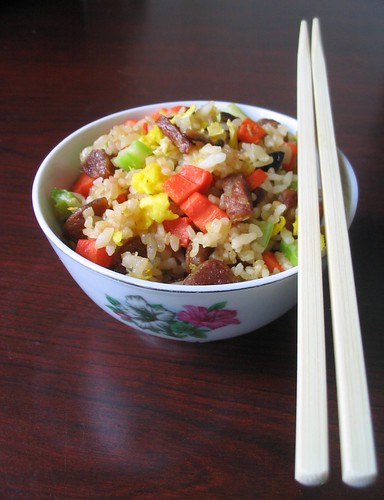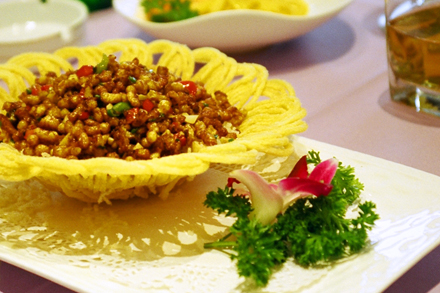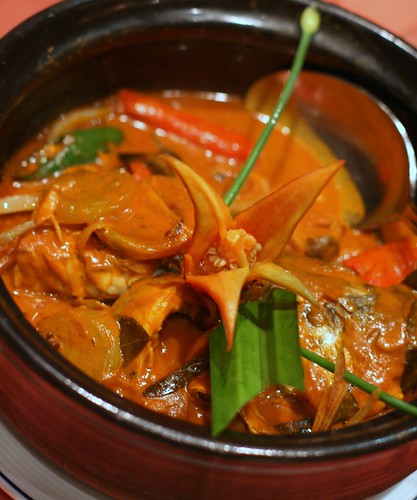




As I promised on my post on October 28th 2007, I made one of my soul food, bakmi ayam jamur pangsit which is one of the types of the Indonesian Chinese cuisine. According to wikipedia, Indonesian Chinese cuisine is characterized by the combination of the Chinese and the local Indonesian style. Adding chili, santan (coconut milk) and other spices, created a new Indonesian Chinese cuisine. The Indonesian Chinese cuisine itself varies depending on the areas, such as in Central Java, the food tends to be sweeter. The more traditional Chinese style can be found in Medan, North Sumatra.
Types of Indonesian Chinese cuisine
- New style of Chinese food with chefs from China, Hongkong or Taiwan.
- The Chinese food from traditional dishes, such as the Teochew, Hokkian, Hakka dishes.
- Chinese-Indonesian food with recipes borrowed from Dutch and other European cuisine as well as local cuisine.
- The halal Chinese food by adapting the local taste, for example by substituting pork for chicken or beef and no alcohol added in food.
Here are several names of the type Indonesian Chinese food:
- Bakmi, it's a call for noodle which is adapted to different styles and regions. Almost every city in Indonesia has its own style noodle or mie, eg. Bakmi Bandung, Bakmi Medan, Bakmi Makassar, Bakmi Bangka, etc. 'Bak-Mi' comes from the Hokkien pronunciation for 'Meat-Noodle'.
- Nasi goreng, Mie goreng. Fried rice or noodle with spices and chili, add in kecap manis (Indonesian sweet soy sauce) to get more flavor and darken.
- Cap Cai, a Hokkian word literally means a mixture of various types of vegetables. Usually served as stir fried mixed vegetables with chicken or shrimp when ordered as ala carte.
- Tahu Goreng, fried Tofu with peanut sauce and chili. 'Tau-Hu' also comes from the Chinese word for 'Bean-Curd'.
- Pau, which is the Chinese word for 'bun'; sometimes written as Bak-Pau, literally meaning 'Meat-Bun', which is a bun with meat fillings. (Bak is the Hokkien pronunciation for 'meat'.)
- Bakwan, came from Bak-Wan, is the Hokkien pronunciation for 'Meat-Ball', usually made from beef. In Indonesia, bakwan is usually a name for a meatballs soup with fried/steamed wonton, noodle, rice noodle, filled fried/steamed tofu etc. It's famous as Malang style bakso.
- Bakso, came from Bak-So, is the Hokkien pronunciation for 'Shredded-Meat'. However , in Indonesia, it can be meant a meatballs soup with noodle and vegetables
- Sapo, came from Sa-Po, which is the Chinese word for 'Clay-Pot'.
Ingredients:
1 pack of fresh noodles(substituted for mi chay, the dried vegetarian noodles)
2 tbsp reduced soy sauce
3 tbsp homemade garlic oil (chicken oil's substitution)
Homemade Garlic Oil
5 cloves garlic, crushed
1 cm ginger, widely sliced
2 green onions, cut a half
100 ml vegetable oil
2 tbsp sesame oil
Stir Fry Chicken and Mushroom
340 g stimulated chicken (veggie chicken ground)
150 g sliced mushroom
3 cloves garlic
3 cm ginger, bruised
1 tbsp kecap manis (Indonesian sweet soy sauce)
1 tbsp reduced soy sauce
75 ml vegetable broth ready to use
salt, sugar and ground white peper as desired
Source : http://indonesia-eats.blogspot.com/2007/11/pesco-vegetarian-version-bakmi-ayam.html





















